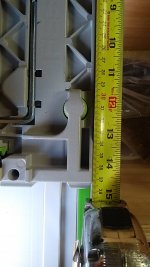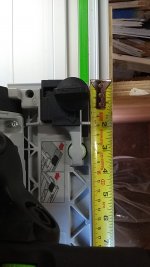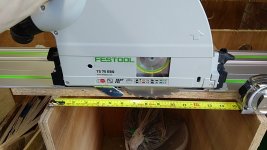mino said:YMMV
I proposed two 55" LR32 and cutting one exactly because the 1900 is too long 99% of the time and the 1080 is too short for a lot of smaller rips still and neither are LR32.
I rarely do full-width cross-cuts. When I do make them, I take the 1400 and extend it a bit by the 376 or take my 1016 and join it with my 632.
The thing is, eventually you will want 2x55" LR32 for full-height cabinets so with 1080 and 1900 you then end up with twice the rails you actually need. Well, given your Kreg kit, kinda 3-times.
I started with 1400 from the TSC set and a "2600" (shortened 2700 so I can store i vertically in a flat), then realized I need to augment the 2700 a bit so made a short piece about 400 mm from the 1400 => 1016 and 376. Then I realized the 1400 is too short for full rips and that I really want the LR32 system. So added 1400 LR32. Then I realized one 1400 LR32 is a PITA when I needed to make 2600 mm cabinets. So I got another LR32 1400 which I cut in 1016 and 376. I then proceeded to cut the 1016 from the original FS/2 again to get 632 from it and 376. I use the 1016 the most, followed by 632, these two joined, then the 2400 + 632. Lastly I again shortened my 2600 to 2400 for ease of storage/handling as I anyway have to extend it most of the time.
In the end, this works well as I have below combinations on hand:
376 + 376 + 376 in SYS-MFT along with the GRSes, clamps and connectors, I use this when need to do something off-shop and do not want to carry the full rail bag.
632 for those ad-hoc short cuts and to augment my 1016 LR32 for full cross-cuts
1016 LR32 - most used, including the LR32 function as is just right for small cabinets
1400 LR32 - bigger cuts the 1016 cannot make
1016 + 632 or 1400 LR32 + 376 - full cross-cuts /rare/
2400 (cut the 2600 again to 2400) + 632 for rips
2400 + 1400 for long rips of raw wood
1400 + 1016 + 632 as my "mobile" set when I need to rip at the wood yard
Long story short, I made three mistakes:
- getting the 2700 thinking I "needed" a long rail base on forum feedback from pros while I am a hobby user ...
- NOT getting the LR32 at the start and going for the set version of my TSC
- getting a set of the Festool connectors /never used, once they arrived realized how bad they are and ordered the Makita ones/
These mistakes mean I now have rails to spare, and get the nice 3x376 combo for mobile work. But really it was not worth the $500+ spent in addition as I rarely need to take out the 2400 and the "mobile" mini-rail set, while nice having it, is not worth it either.
Going at it again, I would definitely start with two 1400 LR32 to cover all bases and consider a shorter rail or cutting one etc. only when those two were "not cutting it" for me.
Ok, thank you very much for taking the time to document your journey. My kreg setup will be getting sold as I migrate to the festool pieces. I have already had a few times that I needed to crosscut a 4' sheet with the kreg and it's 62" rail is fine for that, but since the 1400 will still do it with a bit of care in positioning I suppose that alone is not a good enough reason to get the 1900.
Thanks again!



